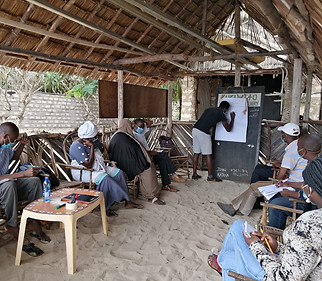
BIOPAMA PROJECTS
EMPOWERMENT OF KURUWITU BEACH MANAGEMENT UNIT (K-BMU) TO IMPLEMENT ITS RECENTLY APPROVED CO-MANAGEMENT AREA PLAN (KCMAP) WITH ATTENTION TO THE SAGE ASSESSMENT IDENTIFIED NEED FOR STRENGTHENING OF INSTITUTIONAL GOVERNANCE AND LEGAL FRAMEWORKS FOR SUSTAINABLE LIVELIHOODS.






This Project has been made possible “With the support of the European Union and the Organisation of African, Caribbean and Pacific States through the BIOPAMA Programme”
ABOUT BIOPAMA
Kuruwitu Co-Management Area, Kilifi County, Kenya, Eastern Africa
PROJECT LOCATION

The Biodiversity and Protected Areas Management (BIOPAMA) programme aims to improve the long-term conservation and sustainable use of natural resources in African, Caribbean and Pacific (ACP) countries, in protected areas and surrounding communities.
It is an initiative of the Organisation of African, Caribbean and Pacific States financed by the European Union’s 11th European Development Fund (EDF), jointly implemented by the International Union for
Conservation of Nature (IUCN) and the Joint Research Centre of the European Commission(JRC).
Building on the first five years of activities financed by the 10th EDF (2012-2017), BIOPAMA’s second phase provides tools for data and information management, services for improving the knowledge and capacity for protected area planning and decision making, and
funding opportunities for specific site-based actions.
BIOPAMA ACTION COMPONENT OBJECTIVES WE ADDRESS:
-
ENHANCE the management and governance of priority areas by addressing existing limitations.
-
ENFORCE the legal framework required to achieve effective biodiversity conservation in protected areas.
-
SUPPORT local communities’ initiatives aiming to enhance the livelihoods of local people whilst effectively contributing to protected areas’ management.
The priority need addressed K-BMU, in their consultative preparation of their KCMA Plan, highlighted over 100 management issues that needed implementation to ensure the sustainability of resource use and secure livelihoods. The implementation of this project will drive three key changes in the Kuruwitu Co-Management Area (KCMA):
1. Management and governance by K-BMU of KCMA enhanced to ensure sustainable
livelihoods from coastal fisheries resources in Kilifi County.
2.Legal framework of K-BMU to implement the KCMA Plan strengthened for sustainable livelihoods and effective biodiversity conservation.
3. Sustainable livelihoods of K-BMU associated value chain actors supported.
GOVERNANCE
Most fishers in Kuruwitu (50-60%) are not yet registered as members of the K-BMU. This means they therefore have no legal rights to fish in the CMA. There is a need to raise member awareness and incorporate a representation of the interests of all actors. The BMU leadership needs to be oriented to their roles and trained in how to:

1) Implement the CMA plan.
2) Protect the rights of members.
3) Jointly address enforcement with KDoF.
4) Address illegal activities.
5) Make members aware of their rights.
6) Ensure members respect the need to comply to the rule of law.
7) Address expectations and ensure sustainable management through the implementation of the CMA.
LEGAL FRAMEWORK
The K-BMU has inadequate by-laws, limited capacity, and little support to enforce the fisheries regulations. With no security of tenure the KBMU has an uncertain ownership of both the CMA, Fish Landing Sites (FLS), access roads, Tengefu (closed areas), and unclear status to exclude non-members. There is a need for an update of the BMU Constitutional By-laws to align with the new CMA. It also calls for clarity in roles between
KBMU and County in the establishment of a co-management partnership and clarity of each actor's roles in the legal enforcement of the regulations.
There is also a need for the development of a Monitoring, Control and Surveillance (MCS) plan to assign roles so that both parties can coordinate and conduct joint enforcement and protect their rights to the
CMA. This should be accompanied by a Marine Spatial Plan (MSP) for the CMA, establishing zoning of who can do what where. The BMU needs to develop and implement legal by-laws (those that are embedded in the Fisheries Act) that govern enforcement and that protect the fisher rights. In addition, in order to assure continuity of user rights, the BMU would need the State Ministry's official gazettement of the rights to the CMA. The legal status of closed areas, like Tengefu, would also need gazettement as per the Fisheries Act.
LIVELIHOODS
The CMA Plan notes the limited role and rights of women and youth groups and others in the value chain. The lack of equity and benefit-sharing amongst various actors. Also included was the poor dissemination of research information and lack of available technical support for new opportunities or alternative livelihoods. Also call for knowledge sharing to initiate new livelihoods and enhance the value chain blue economy (e.g., octopus closures for women, improvement of fish mongers hygiene, access to the fishery in deeper waters, more Tengefus for additional eco-tourism and to protect critical fish habitats and turtle nesting sites.
